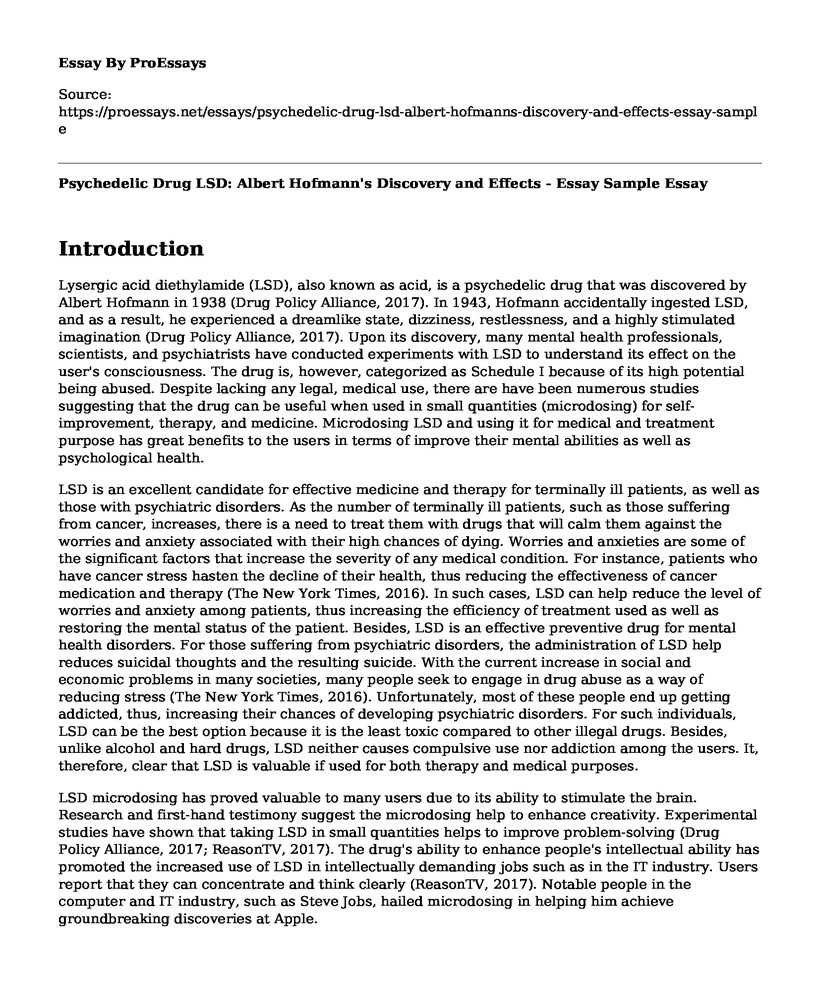Introduction
Lysergic acid diethylamide (LSD), also known as acid, is a psychedelic drug that was discovered by Albert Hofmann in 1938 (Drug Policy Alliance, 2017). In 1943, Hofmann accidentally ingested LSD, and as a result, he experienced a dreamlike state, dizziness, restlessness, and a highly stimulated imagination (Drug Policy Alliance, 2017). Upon its discovery, many mental health professionals, scientists, and psychiatrists have conducted experiments with LSD to understand its effect on the user's consciousness. The drug is, however, categorized as Schedule I because of its high potential being abused. Despite lacking any legal, medical use, there are have been numerous studies suggesting that the drug can be useful when used in small quantities (microdosing) for self-improvement, therapy, and medicine. Microdosing LSD and using it for medical and treatment purpose has great benefits to the users in terms of improve their mental abilities as well as psychological health.
LSD is an excellent candidate for effective medicine and therapy for terminally ill patients, as well as those with psychiatric disorders. As the number of terminally ill patients, such as those suffering from cancer, increases, there is a need to treat them with drugs that will calm them against the worries and anxiety associated with their high chances of dying. Worries and anxieties are some of the significant factors that increase the severity of any medical condition. For instance, patients who have cancer stress hasten the decline of their health, thus reducing the effectiveness of cancer medication and therapy (The New York Times, 2016). In such cases, LSD can help reduce the level of worries and anxiety among patients, thus increasing the efficiency of treatment used as well as restoring the mental status of the patient. Besides, LSD is an effective preventive drug for mental health disorders. For those suffering from psychiatric disorders, the administration of LSD help reduces suicidal thoughts and the resulting suicide. With the current increase in social and economic problems in many societies, many people seek to engage in drug abuse as a way of reducing stress (The New York Times, 2016). Unfortunately, most of these people end up getting addicted, thus, increasing their chances of developing psychiatric disorders. For such individuals, LSD can be the best option because it is the least toxic compared to other illegal drugs. Besides, unlike alcohol and hard drugs, LSD neither causes compulsive use nor addiction among the users. It, therefore, clear that LSD is valuable if used for both therapy and medical purposes.
LSD microdosing has proved valuable to many users due to its ability to stimulate the brain. Research and first-hand testimony suggest the microdosing help to enhance creativity. Experimental studies have shown that taking LSD in small quantities helps to improve problem-solving (Drug Policy Alliance, 2017; ReasonTV, 2017). The drug's ability to enhance people's intellectual ability has promoted the increased use of LSD in intellectually demanding jobs such as in the IT industry. Users report that they can concentrate and think clearly (ReasonTV, 2017). Notable people in the computer and IT industry, such as Steve Jobs, hailed microdosing in helping him achieve groundbreaking discoveries at Apple.
Additionally, LSD does not have any long-term negative physical or psychological effect on the users, thus making the drug safe for use. The negative short-term impact can only occur LSD is used in large quantities instead of micordosing. However, in the case of an overdose, it does not cause any fatal consequences such as shock or death, like in other Schedule I drugs (Drug Policy Alliance, 2017). Using LSD in small quantities, therefore, help boost the economic productivity of the society by promoting innovation in different sectors, as well as helping people to solve severe problems in the workplace and community in general.
Microdosing and the use of LSD in medicine and therapy is clearly beneficial to the users. The drug's ability to suppress anxiety and worry make it a possible choice for use in treating people with the psychiatric disorder as well as help to suffering from terminal conditions to cope with the situation. Besides, microdosing helps stimulates the brain, thus promoting the much-needed creativity and problem-solving ability in the modern competitive society. It is, therefore, clear that it is beneficial to use LSD in medicine and therapy, as well as, in self-improvement through microdosing.
References
Drug Policy Alliance. (2017). LSD facts sheet. Drug Policy Alliance, 1(1), 1-5. [email protected]
The New York Times. (2016, May 16). LSD's Long, Strange Trip | Retro Report | The New York Times. YouTube. https://www.youtube.com/watch?v=WouOr579mfY&t=19s&list=PLryhTBGRtWCowGloKosSh0Fbt7u-1m4rg&index=1
ReasonTV. (2017, June 26). LSD Microdosing: The New Silicon Valley Productivity Hack [Video]. YouTube. https://www.youtube.com/watch?v=MPAFah0iTDM&index=8&list=PLryhTBGRtWCowGloKosSh0Fbt7u-1m4rg
Cite this page
Psychedelic Drug LSD: Albert Hofmann's Discovery and Effects - Essay Sample. (2023, Apr 26). Retrieved from https://proessays.net/essays/psychedelic-drug-lsd-albert-hofmanns-discovery-and-effects-essay-sample
If you are the original author of this essay and no longer wish to have it published on the ProEssays website, please click below to request its removal:
- Power Vacuums and Violence Essay
- Research Paper on Immigration and Europe
- Analytical Research Paper on Racial Profiling
- Research Paper on Terrorism in America in Today's Society
- Essay Sample on Drug-Induced Psychosis
- Critical Essay on Top Girls: Women's Journey to Success in a Male-Dominated World
- Essay Example on Modern-Day Slavery: Human Trafficking in Developed Nations







